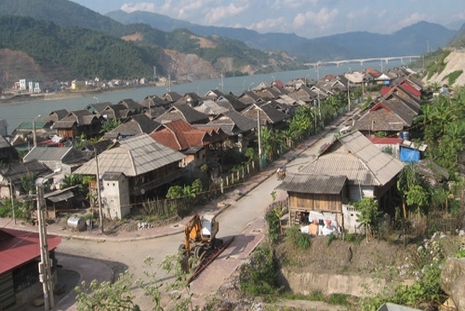|

The name Muong Lay has become a landmark in the map of travelers to
northwest Vietnam. Formerly known as
Lai Chau, this small town is nestled in a pretty valley carved
from spectacular mountains by the Da River, and makes a good lunch or overnight
stop for people travelling between
Dien Bien Phu and
Sapa. Beneath Muong Lay's
beauty lies a difficult existence for locals. Despite a marked increase in
tourist numbers, for most of the people it's a hard living. Far from busy trade
routes, normal commerce is limited and the town has only been really successful
in harvesting cash crops such opium and timber. Needless to say, opium
harvesting does not find favour with the central government, which has been
trying to discourage the Montagnards from producing poppies. If the opium
business is falling on hard times, the same must be said for the timber
industry. In recent years the forest cover has been reduced and flooding has
increased dramatically. Around 140 people lost their lives in 1990 in a
devastating flood on the Da River that swept through the narrow valley. An even
worse flood in 1996 killed 100 people and cut all roads into town for two
months; the ruins of the flooded former cultural hall can be seen in the middle
of town. It seems that this kind of flooding will become a permanent feature of
Muong Lay. There is a massive dam under construction, just above the current
Song Da Reservoir, and this will fill the valley with water. When this comes to
pass (not before 2010), this will be the largest hydroelectric station in
Southeast Asia. It also could mean that in the future the only way to visit Muong Lay will be by submarine. Being underwater, however, would at least keep
things cooler. Odd as it might seem, in summer Muong Lay is one of the hottest
places in Vietnam. June and July temperatures can soar as high as 40°C.
BORDER CROSSING: TAY TRANG/SOP HUN
The Lao border at Tay Trang, gateway to Phongsali province, is only 34km from
Dien Bien Phu. Persistent rumours circulate about this crossing opening to
foreign tour ists soon, but at the time of writing it was still closed. OK, so
we've said it for a few years now, but it really is likely to open during the
lifetime of this book. Keep your ear to the ground and do your homework in
Hanoi. Check out the motorbiking website GT Rider for the latest, as these guys
are eagerly waiting for !t to open.
Getting There & Away
Most travellers arrive from Dien Bien Phu (three hours, 103km), although there's
also the rocky road option of Hwy 6 from Tuan Giao (four hours, 96km). The road
trom Lai Chau to Sapa (six hours, 155km) is one of the most beautiful drives in
Vietnam, particularly the final climb up over the Tram Ton Pass. Public buses
make the run to/from Hanoi, as well Dien Bien Phu (35,000d, three hours') and
Sapa (53.000d).
ALL CHANGE IN THE NORTH
There's been a lot of confusing name changes in the northwest in the past couple
of years. A large chunk of old Lai Chau province, including the provincial
capital, is due to go under water in a few more years. The government struck
first and created the new province of Dien Bien Phu and relocated the province
of Lai Chau to the northeast. The old town of Lai Chau is now Moung Lay the old
town of Tam Duong is now Lai Chau, the provincial capital of the new province;
and the'old town of Binh Lu is now Tarn Duong. Confused? So were we. More than a
few travellers have been jumping off the bus in the new town of Lai Chau,
hunting for the popular
Lan Anh
hotel. No, that's in Muong Lay - the old Lai
Chau, Yeahhhh |
